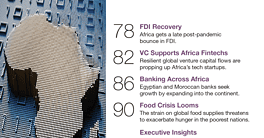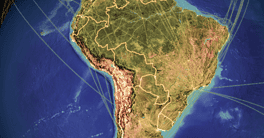Latin America’s economies are benefitting from a lively and innovative fintech sector.

Already Latin America’s largest neobank, São Paulo–based fintech Nubank might top the $55.4 billion market value of Itaú Unibanco, Brazil`s leading legacy bank, when Nubank launches its planned Nasdaq IPO, according to wire service reports. This comes as no surprise. Instead, it symbolizes the surge in Latin American fintechs.
“There are 1,005 technology companies born in the region that [have each] raised over $1 million,” according to a recent report by the Inter-American Development Bank. “Fintech and e-commerce represent 72% of the [Latin American and Caribbean startup] ecosystem value.”
Before the pandemic, Latin American e-commerce was already growing by 20% a year and set to be worth $187 billion this year. Amid the 2020 lockdowns, it jumped by over 54% compared to 2019. Mobile internet users in the region should reach 424 million by 2025. That is all according to a report published this year by PayU, a global fintech operator. In 2010, Brazil had only two payment-acquiring firms; now it has almost 500, says Rodrigo Schemann, commercial director at Unlimint Brazil, the São Paulo branch of the global fintech firm.
“In all markets, digital opportunities are growing; but in Latin America, the pace has been incredibly fast,” says Lauren Morton, partner at QED Investors, a venture capital firm.
The growth in digital banks and payment tools is fueled by several factors: tapping into the region`s huge market of unbanked and underbanked citizens, the preference of throngs of young adults for online financial services, favorable regulatory moves in many countries, and enthusiastic backing from local and international venture capital funds.
Fintechs are earning cash from financial inclusion. “By embracing stringent underwriting requirements and limiting access to financial products, incumbent banks in Latin America exclude a large portion of the population,” says an online report by Angela Strange, general partner; and Matthieu Hafemeister, partner, at venture capital firm Andreessen Horowitz. “In Mexico, for example, over 50% of people are unbanked; over 30% have no access to any financial product; and just 31% have access to credit products.” Most economies are largely cash based; the authors add.
“Companies have tried to target segments that the incumbents are not interested in,” says Adal Flores, CEO, and co-founder of the buy-now-pay-later fintech Kueski, which dubs itself the largest online consumer lender in Mexico. “It is appealing to target those markets. They’ll go upscale when they become stronger and bigger.” A company survey shows that 60% of its customers started to build their credit history with Kueski.
The pandemic helped spur fintech growth in this segment. “Before the pandemic, only a small percentage of people in Brazil had a digital wallet,” says Schemann. “Before, 60%-70% did not have access to any kind of digital system. Now that number is under 30%.” This was partly fueled by government efforts to boost financial inclusion, including the distribution of stimulus cash to citizens via digital wallets.
Many observers believe that traditional banks would like to tap this market but are hamstrung by regulations and higher costs of customer acquisition. Meanwhile, countries such as Brazil, Chile and Mexico are adopting fintech-friendly reforms. “One key has been regulatory clarity, especially in Brazil,” says Morton.
Tech-hip young people at the base of what Flores calls the “age pyramid” represent another key growth market. “In Mexico, 43% of the population is under the age of 25. This large, youthful consumer base expects their banking service to mirror the consumers’ apps more closely they use on a regular basis,” says the Andreessen Horowitz report. “Additionally, smartphone usage is becoming the norm rather than the exception.…Brazil is WhatsApp’s second biggest market, with 120 million users.”
Flores and José Vargas-Favero, executive vice-president and managing director in Latin America for Provenir, a risk-analysis solutions provider, both brought up another factor: distrust among younger people of traditional financial institutions due financial crises in recent decades. Mexican banks “filled parking lots with (repossessed) cars and repossessed homes” during the 1995-97 Tequila Crisis, Vargas-Favero recalled.
This has opened opportunities for fintechs, spurring growth in the digital sector. South American giant Brazil leads the way, as seen with recent funding rounds by EBANX, a payment provider, and Neon, a digital bank. “What I see in Latin America are pockets of tremendous growth in the main economies,” says Vargas-Favero. Besides Brazil, the shortlist usually includes Mexico, Colombia, Chile, and Peru.
In Central America, Panama could be an exception. “Despite being in its infancy, e-commerce is strong in Panama,” according to the PayU report. “This is due to a combination of its multiple free trade zones; strong links with other Latin American markets; competitive labor costs; and, most notably, well-established trade infrastructure thanks to the Panama Canal. Smartphone penetration is high in the country, and more people are now purchasing goods and services on the internet.” According to Vargas-Favero, “Startups in El Salvador, Costa Rica and Panama will usually begin with all six countries.”
Startups are gaining market share and brand recognition in all segments: from banking and credit to areas such as investing and insurance for consumers, and payroll and point-of-sale services for small business. Cora (Brazil) and Xepelin (Chile) focus on small businesses. Xepelin has also opened shop in Mexico, becoming part of a cross-border trend. Brazilian lender Creditas also expanded to Mexico, as has Ualá, a personal financial management mobile app developed in Argentina. Uruguayan payments firm dLocal might lead the league, having expanded to 29 countries in Latin America and beyond, including Asia Pacific, the Middle East and Africa.
“You had strong founders who started companies five to nine years ago, most of whom had studied and worked abroad, mostly in the US,” says Kueski’s Flores, who speaks English, Chinese and Portuguese. “They were able to understand what was happening globally as well as in their own countries.”
The international mindset stands in stark contrast to that of legacy banks, which tend to stick close to home, with a handful of champions usually dominating local markets. Itaú Unibanco is a notable exception, with operations in 20 countries outside of Brazil: seven in the region and the rest around the world. Some observers chalk up the penchant for cross-border moves among fintechs to the influence of venture capital investors. “There is strong pressure to establish that they can go beyond their home countries,” says Carmelo Gordian, a partner in the law firm Shearman & Sterling. “The better companies have dots on the map.”
Latin American financial services companies have received over $7 billion in investment since 2016, according to data from Crunchbase, a business information firm. Volume has been up year-on-year, and 2021 should be no different: “Investment will almost certainly eclipse” the $2 billion recorded in 2020, according to the firm’s news arm. A report from the Association for Private Capital Investment in Latin America, a not-for-profit membership organization, also highlighted the trend: Fintech startup firms accounted for $1.6 billion, or 40% of the regional venture capital invested last year.
The region boasts 27 heavyweight domestic VCs in five countries, according to SaaStock, a firm that provides a community for entrepreneurs of software-as-a-service firms. Seventeen of them are based in Brazil. Top foreign firms, notably from the United States, including Goldman Sachs, QED and Andreessen Horowitz, have joined the party. “The growth in venture capital has been dramatic,” says Gordian. “It mirrors what happened in the US 20 years ago.”



